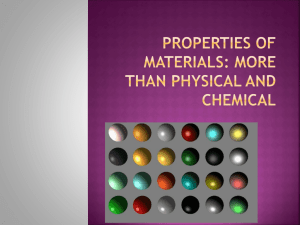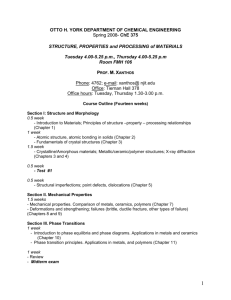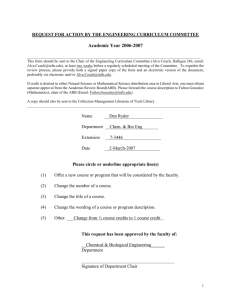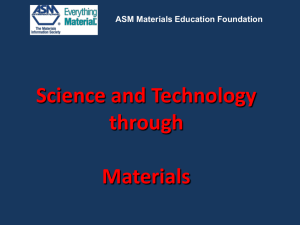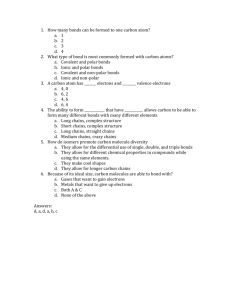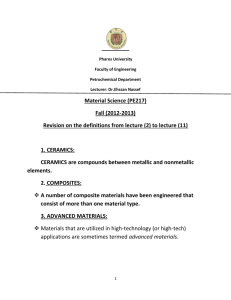State how the microstructure of polymers differs from metals and... State how the mechanical and physical properties of polymers differ... Quiz 7 and 8 Polymers
advertisement
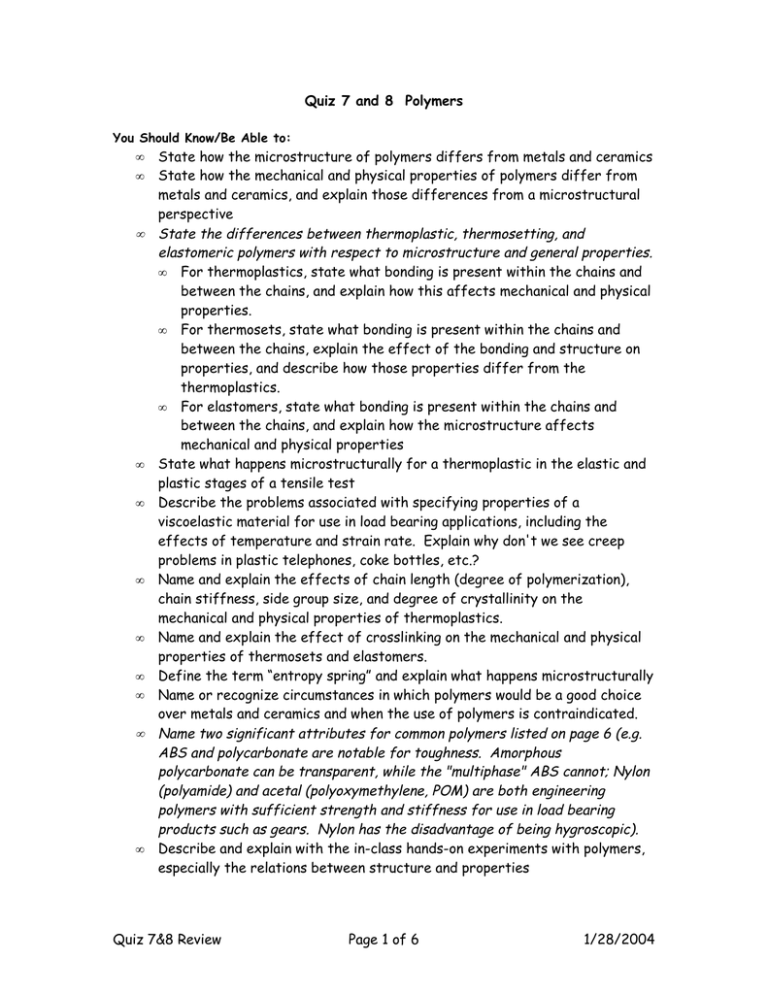
Quiz 7 and 8 Polymers You Should Know/Be Able to: • • • • • • • • • • • State how the microstructure of polymers differs from metals and ceramics State how the mechanical and physical properties of polymers differ from metals and ceramics, and explain those differences from a microstructural perspective State the differences between thermoplastic, thermosetting, and elastomeric polymers with respect to microstructure and general properties. • For thermoplastics, state what bonding is present within the chains and between the chains, and explain how this affects mechanical and physical properties. • For thermosets, state what bonding is present within the chains and between the chains, explain the effect of the bonding and structure on properties, and describe how those properties differ from the thermoplastics. • For elastomers, state what bonding is present within the chains and between the chains, and explain how the microstructure affects mechanical and physical properties State what happens microstructurally for a thermoplastic in the elastic and plastic stages of a tensile test Describe the problems associated with specifying properties of a viscoelastic material for use in load bearing applications, including the effects of temperature and strain rate. Explain why don't we see creep problems in plastic telephones, coke bottles, etc.? Name and explain the effects of chain length (degree of polymerization), chain stiffness, side group size, and degree of crystallinity on the mechanical and physical properties of thermoplastics. Name and explain the effect of crosslinking on the mechanical and physical properties of thermosets and elastomers. Define the term “entropy spring” and explain what happens microstructurally Name or recognize circumstances in which polymers would be a good choice over metals and ceramics and when the use of polymers is contraindicated. Name two significant attributes for common polymers listed on page 6 (e.g. ABS and polycarbonate are notable for toughness. Amorphous polycarbonate can be transparent, while the "multiphase" ABS cannot; Nylon (polyamide) and acetal (polyoxymethylene, POM) are both engineering polymers with sufficient strength and stiffness for use in load bearing products such as gears. Nylon has the disadvantage of being hygroscopic). Describe and explain with the in-class hands-on experiments with polymers, especially the relations between structure and properties Quiz 7&8 Review Page 1 of 6 1/28/2004 Polymers (many repeating units) Long chain (macro) molecules with primary bonds along the chains. Bonds between chains can be primary or secondary. The microstructure can be viewed as spaghetti. Strength mostly depends on how easy it is to move strands of spaghetti relative to each other. Comparison of Properties with Metals and Ceramics • low stiffness (1-3 orders of magnitude less than metals, ceramics) • lower strength (order of magnitude) than metals, ceramics • ductility from 0-600% (ceramics≈0%, ceramics 0-50%) • some have extraordinary (400%) elastic deformation (elastomers) (metals and ceramic are less than a few percent) • much lower maximum operating temperatures than most metals and ceramics • easily manufactured into complex shapes (injection molding, extrusion, blow molding) • can have good specific strength (esp. fibers) due to low density (Kevlar, Spectra have specific strength higher than steel) • can modify appearance - color, lustre, texture (less easy with metals, ceramics) Reason for Property differences with Metals and Ceramics • Secondary bonds between chains are relatively weak and allow chain motion under stress, leading to lower strength and stiffness than materials with all primary bonds • Weak secondary bonds result in softening (for thermoplastics) at relatively low temperatures reducing temperature of use, but making processing much easier. Polymerizing (addition polymerization) H R Free Radical breaks double bond and bonds with Carbon H C C H H Unsaturated (double bond) allows chain to form. When double bond is broken, carbon has an open bonding site and chain forms H R H H H H H C H C C C C C H H H H H or H H C C H H n Molecular shape • Linear - Easier to crystallize (many thermoplastics) • Branched - Harder to crystallize (amorphous) (some thermoplastics) • Crosslinked - Primary bonds between chains (thermosets and elastomers) • Network - Trifunctional mers form amorphous 3-D networks (thermosets) Molecular configuration • Isotactic - side group on same side • (easiest to crystallize) Syndiotactic - side group on alternate sides Quiz 7&8 Review Page 2 of 6 H R H R H R C C C C C C H H H H H H 1/28/2004 H • R H H H R C C C C C C H H H R H H H R H R H H C C C C C C H H H H H R Atactic - side group at random locations (very hard to crystallize) Copolymers (similar to alloying in metals, but with mers rather than elements) • Random - different mers occupy different sites along the chain !-!-!-!-!-!-!-!-!-!-!-!-! • Alternating - different mers alternate along the chain !-!-!-!-!-!-!-!-!-!-!-!-! • Block - different mers alternate in groups !-!-!-!-!-!-!-!-!-!-!-! • Branched - one mer along the chain, other on the branches Thermoplastic Thermoset Elastomer (softens upon heating) (cures upon heating) (significant elastic deformation) • primary bonds along • primary bonds along • primary bonds along chain chain chain • few primary bonds • primary bonds • secondary bonds between chains between chains between chains • highly “coiled” chains • usually can recycle (as • difficult to recycle • difficult to recycle • simple shapes can be same product • “vulcanized” rubber pressed, some • usually easier to • Latex rubber, injection molded fabricate (injection Neoprene, silicone • Phenolic (bakelite, mold, extrude, blow rubber Epoxy, Polyester mold) (Bondo) • Polyethylene (PE), Nylon (PA), Delrin (POM), Lexan (PC), Acrylic (Plexiglas) (PMMA) Response to Stress Quiz 7&8 Review Page 3 of 6 1/28/2004 Stress First PeakYield Strength Highest Peak Ultimate Tensile Strength Drawing - Chain coiling and uncoiling - Crystalline packets separate and align Bond stretching (secondary and primary) Strain Note: In polymers, yield is not doe to planer slip from dislocation motion, but typically from chain uncoiling. Therefore, strengthening procedures used for metals are inappropriate. Rather, strengthening of thermoplastics is by prevention/impeding of chain motion. Crystallinity • No polymers are fully crystalline • Many thermoplastics are amorphous (Lexan, Plexiglass, polystyrene) • Some thermoplastics are partly crystalline (nylon, acetal, PET) • 3-D order comes from chain folding and alignment • Crystalline regions alternate with amorphous regions • Thermosets are never crystalline Effect of: Molecular Weight (degree of polymerization) Side Groups Bonding (secondary) Crystallinity Crosslinking Drawing Quiz 7&8 Review on Properties Longer chains cause more entanglement and impede uncoiling, therefore higher strength and stiffness Bulky side groups on the chain impede uncoiling Highly polar molecules have stronger secondary bonds, impede uncoiling In crystalline portions molecules packed more tightly and secondary bonds are stronger Primary bonds between chains impede uncoiling Chains align in amorphous regions, small packets of crystallites separate and align. Further uncoiling is difficult. Page 4 of 6 Example Octane" LDPE" HDPE " UHMWPE Polystyrene PVC, PTFE (Teflon) Nylon, Acetal Thermoset, epoxy Fibers (nylon, Kevlar) 1/28/2004 Annealing Heating a semicrystalline polymer can organize, improve crystals Heating a drawn polymer can disorganize, weaken Viscoelasticity A significant design challenge of polymers is that the material properties are time dependent and temperature dependent. This can create any number of problems. The relationship between Elastic modulus and temp for a thermoplastic is shown below. Log E Glassy Example: Vinyl garden hose may be flexible above Tg (summer) and rigid below Tg (winter). Note that the vertical axis is log scale. Modulus can change by orders of magnitude in a small temperature range. Leathery Rubbery Temp Tg, Glass Transition Temp Glass Transition Temperature – Transition from flexible to glassy. Chain coiling is prevented by temperature (thermal contraction means less room for motion) Melting Temperature – Transition from Crystalline to Amorphous (NOT necessarily the solid-liquid transition, e.g. liquid crystal polymers) Volume Volume Volume Tg Amorphous Temp Tm Crystalline Temp Tg Tm Temp Semicrystalline Creep – Progressive strain over time at constant stress (polymers, esp. those above Tg, and metals at temps high w.r.t. melting) Stress Relaxation – Progressive loss of tension over time at constant deflection (polymer bolts, guitar strings) Rules of Thumb • Try not to have polymers under constant load • Use glass-filled grades for load bearing Quiz 7&8 Review Page 5 of 6 1/28/2004 Crystallinity • No polymers are fully crystalline • Many thermoplastics are amorphous (Lexan, Plexiglass, polystyrene) • Some thermoplastics are partly crystalline (nylon, acetal, PET) • 3-D order comes from chain folding and alignment • Crystalline regions alternate with amorphous regions • Thermosets are never crystalline Elastomer Behavior • Large deformation from chain uncoiling • No chain sliding due to light cross linking (keep the same neighbor chains) • Full elastic recovery due to entropy (chains are at lowest energy when randomly coiled, and will spontaneously return to that approximate amount of coiling if sufficient thermal energy is available for random chain motion.) • There will be a difference between the elastic load and unload curve on a stress-strain diagram. This hysteresis represents the energy lost in the process (damping). Manufacturing In general, polymers can be easily formed into shape with few secondary heat-treating or finishing steps. This can lead to a relatively inexpensive part despite relatively high material cost. • • • • Compression Molding – Heat and pressure in a die to form and cure a thermoset (electrical switchplates, Injection Molding – Hot plastic (usually thermoplastic) forced into a mold which can have significant complexity. (Process is similar to die casting of metals) (toys, gears, phone housings) Extrusion – Hot plastic (usually thermoplastic) is forced through a die to make parts with constant cross section Blowmolding - Inflating a parison to make bottles (bottles, gas cans, gas tanks) Types of Polymers See Table 16.3 Quiz 7&8 Review Page 6 of 6 1/28/2004

